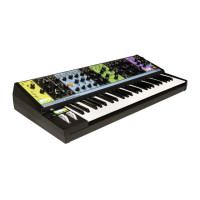25
Sounds change over time. How they change
over time is part of what makes each one unique.
Some sounds begin abruptly, like the strike of a
drum. Some sounds end just as quickly, and some
linger like a held chord on a piano. We call this
the envelope of a sound. Matriarch uses a pair of
identical Envelope Generators to create control
voltages that also change over time. This type of
control voltage can be applied to the amplitude
of the sound, changing its volume over time. This
same type of control voltage can also be used to
affect the Cutoff frequency of the Filter over time,
creating changes in timbre, or tone.
NOTE: In a semi-modular synthesizer such as Matriarch,
an Envelope Generator can be patched to modulate any
controllable parameter over time.
MODULE PROVENANCE: Matriarch’s Envelope
Generators are based on the classic Moog 911 module.
Regardless of how the Envelope
is applied, there are four main
stages: Attack time, Decay time,
Sustain level, and Release time.
These controls are identical for
both Envelope Generators.
Of these four stages, three relate
to time, and are controlled by
rotary knobs. Only the Sustain
stage relates to level; it is
controlled using a slider.
ATTACK
The ATTACK knob determines the amount of time required for the control
signal to rise from zero to its maximum level once a key is pressed. The ATTACK
knob has a range from 2 milliseconds to 10 seconds. Fast attacks are useful for
creating plucked sounds, while slow attacks are more useful for creating bowed
string sounds and swells. Brass swells will often have a faster Amplitude Attack
and a slower Filter Attack.
attack
decay
sustain
release
time
ENVELOPE GENERATORS (ADSR)

